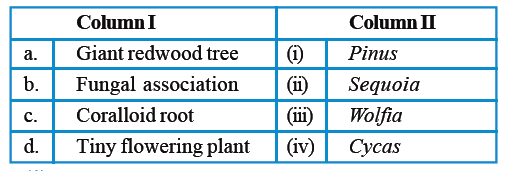Select the correct match with the feature given along
Insulin - Dipeptide with disulfide bonds
Guanine - Substituted pyrimidine
RNA - Phosphodiester bonds
Cellulose - Unbranched, storage homopolymer.
To solve the question of selecting the correct match with the given features, we will analyze each option provided in the question step by step.
Step 1: Analyze the first option - Insulin
- Feature Given: Insulin is described as a dipeptide with disulfide bonds.
- Explanation: Insulin is actually a polypeptide hormone composed of 51 amino acids, not a dipeptide (which consists of only two amino acids). It has two chains (A and B) linked by disulfide bridges.
- Conclusion: This option is incorrect.
Step 2: Analyze the second option - Guanine
- Feature Given: Guanine is described as a substituted pyrimidine.
- Explanation: Guanine is actually a substituted purine, not a pyrimidine. Purines have a double-ring structure, while pyrimidines have a single-ring structure. Guanine and adenine are both purines, while cytosine, thymine, and uracil are pyrimidines.
- Conclusion: This option is incorrect.
Step 3: Analyze the third option - RNA
- Feature Given: RNA has phosphodiester bonds.
- Explanation: RNA is a nucleic acid made up of ribonucleotides that are connected by phosphodiester bonds, which link the 5' phosphate group of one nucleotide to the 3' hydroxyl group of another. This is indeed correct.
- Conclusion: This option is correct.
Step 4: Analyze the fourth option - Cellulose
- Feature Given: Cellulose is described as a storage homopolymer.
- Explanation: Cellulose is a structural polysaccharide that forms the cell wall of plants and is not a storage polysaccharide. It is made up of glucose units, but it serves a structural role rather than a storage role.
- Conclusion: This option is incorrect.
Final Answer
The only correct match from the options provided is the third option: RNA has phosphodiester bonds.
---
- Feature Given: Insulin is described as a dipeptide with disulfide bonds.
- Explanation: Insulin is actually a polypeptide hormone composed of 51 amino acids, not a dipeptide (which consists of only two amino acids). It has two chains (A and B) linked by disulfide bridges.
- Conclusion: This option is incorrect.
- Feature Given: Guanine is described as a substituted pyrimidine.
- Explanation: Guanine is actually a substituted purine, not a pyrimidine. Purines have a double-ring structure, while pyrimidines have a single-ring structure. Guanine and adenine are both purines, while cytosine, thymine, and uracil are pyrimidines.
- Conclusion: This option is incorrect.
- Feature Given: RNA has phosphodiester bonds.
- Explanation: RNA is a nucleic acid made up of ribonucleotides that are connected by phosphodiester bonds, which link the 5' phosphate group of one nucleotide to the 3' hydroxyl group of another. This is indeed correct.
- Conclusion: This option is correct.
- Feature Given: Cellulose is described as a storage homopolymer.
- Explanation: Cellulose is a structural polysaccharide that forms the cell wall of plants and is not a storage polysaccharide. It is made up of glucose units, but it serves a structural role rather than a storage role.
- Conclusion: This option is incorrect.
The only correct match from the options provided is the third option: RNA has phosphodiester bonds.
Topper's Solved these Questions
- TEST 1BOOK - AAKASH INSTITUTE ENGLISHCHAPTER - TEST 1EXERCISE - Examplle
19 Videos
- STRUCTURAL ORGANISATION IN ANIMALS (CONTD . . .) (ANIMAL MORPHOLOGY)BOOK - AAKASH INSTITUTE ENGLISHCHAPTER - STRUCTURAL ORGANISATION IN ANIMALS (CONTD . . .) (ANIMAL MORPHOLOGY)EXERCISE - Assignment (Section-D)
10 Videos
- TEST 2BOOK - AAKASH INSTITUTE ENGLISHCHAPTER - TEST 2EXERCISE - EXERCISE
619 Videos
Similar Questions
Select the correct matching

View SolutionSelect the correct matching-

View SolutionSelect a correct match:
View SolutionSelect out the correct match
View SolutionSelect a correct match
View SolutionSelect a correct match
View SolutionSelect the correct matched pair
View SolutionSelect the correct matched pair
View SolutionSelect correct match :

View SolutionSelect correct match:

View Solution
